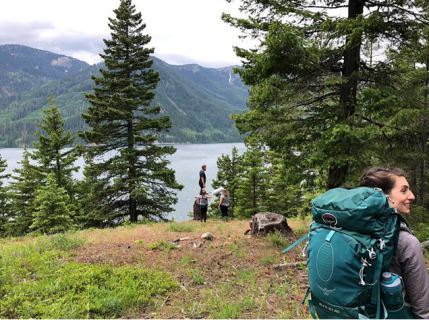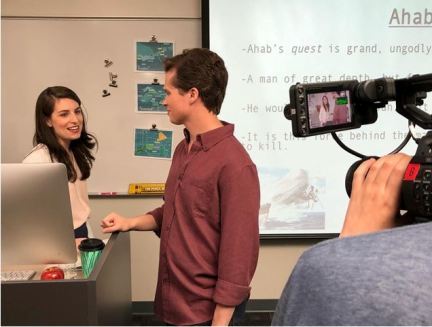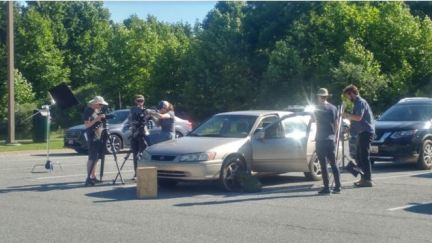4 Things Writers Can Learn From Making a Movie
 I’ve been a book editor and a writer for a number of years now. As an author, I have one published novel in The Listeners; as an editor, I’ve worked on more than seventy. I’ve written screenplays that were optioned but never made, and I’ve sat at book signings to which no one showed up. I’ve spoken at conferences to audiences full of aspiring writers, I’ve counseled authors, and I’ve taught high school students the craft of fiction.
I’ve been a book editor and a writer for a number of years now. As an author, I have one published novel in The Listeners; as an editor, I’ve worked on more than seventy. I’ve written screenplays that were optioned but never made, and I’ve sat at book signings to which no one showed up. I’ve spoken at conferences to audiences full of aspiring writers, I’ve counseled authors, and I’ve taught high school students the craft of fiction.
But this summer brought an experience I’ve never had before, and one reasonably likely never to happen.
This summer I saw the filming of my very first movie.
As my cryptozoological dramedy Ape Canyon now navigates its way through post-production, I find myself considering four important lessons I’ve learned through this process.

Ape Canyon co-lead Anna Fagan (Samantha Piker) in the foreground with members of the crew behind (Gabby Sturgeon on sound, alongside production designer Jari Neuman and, on a tree stump, gaffer Ty Gentner) during filming in the area of Roslyn, WA.
1. Never Abandon a Good Story
More than one member of the remarkable cast and crew of Ape Canyon asked me what it was like to finally see the production of something that had existed in my head for a year or two. I had to correct them: it’s been so much longer than that.
Ape Canyon is a screenplay I started thinking about in 2009. I started writing it in 2011, and writing it in earnest in 2013, completing it in 2014. I have a lot of other screenplays, and a litany of short stories I saw myself adapting into short films. I didn’t know Ape Canyon would resonate with director Josh Land and director of photography Victor Fink when I met them in 2016, and I sure didn’t know we’d be filming it in 2018.
If I’d let Ape Canyon go when it was just an idea or abandoned it after 2011, or if I hadn’t committed myself to finishing it in 2013, or if I’d forgotten it when it didn’t set the world on fire immediately in 2014, then I would never have had the experience of watching it come to life before my eyes.

Leads Anna Fagan and Jackson Trent (Cal Piker) in the lens of director of photography Victor Fink.
2. A Good Writer Must Be Agile
This is a lesson I preach to my clients in fiction and memoir, but it can be a tough one to put into practice. What I wrote in the Ape Canyon script was the film as I envisioned it—but it turns out films have budgets. And when you’re making an indie film, those budgets provide some limitations. It’s on you—and your team—to adjust on the fly and come up with ways to maintain the integrity of the story while remaining realistic relative to what you can actually do.
One particular problem area was the sequence in which protagonist Cal Piker (played, beautifully, by Jackson Trent) gets lost in the woods. In the screenplay, this happens during a storm. But you can’t control the rain. He falls into a rain-swollen river and nearly drowns, but that’s a major, costly stunt. So we lost the storm. We lost the river. Cal fell down a hill. (And Jackson, fortunately, was not injured.)

Though not badly injured, Cal has had a very rough couple of days. Anna and Jackson, with Gabby operating the boom mic.
The real tricky part, though, was the squirrel.
As written, Cal wanders into the woods because he thinks he hears Bigfoot. He realizes he’s lost after he discovers the true source of the sound: a squirrel, scampering away. It was virtually impossible on our budget to get a squirrel to scamper about the woods on cue—but equally impossible to control another animal, or a gust of wind, or whatever else might make a similar sound.
Josh suggested trash left in the woods. From there I proposed a bag hanging in the trees, as campers sometimes do to keep their supplies away from animals. Through some careful adjustments, we had a pretty great sequence—not the one I envisioned, but one that works just as well.
It wouldn’t have happened without Josh. That brings me to the third lesson.
3. Respect the Collaborative Process
Writing is frequently a solo act, but revision comes often with the creative input of others. Film compounds this, because film is all about collaboration. Without collaboration, and the teamwork of many creative people, there can be no film. This is one of the central ways in which the filming of Ape Canyon was unlike anything I’ve ever experienced.
We ran into another budget issue with the car chase scene. First we had to lose the chase. Then we had to lose the highway. Soon the car could hardly move at all. I tried to be agile. I wrote three alternative versions of this scene and did everything I could to make them at least almost as good as what I’d written originally. But I wasn’t happy about it.
I was there the day this scene was filmed—and I discovered Josh, Victor, and the rest of the team had done something amazing. They’d kept the dialogue and the arc of the most budget-friendly version of the scene, but they’d also sped it up, transforming it from sardonic to manic. It was a brilliant change because it maintained the energy of the chase within the confines of our limited budget. It wasn’t my idea, but it’s exactly what I would have written had I thought about it.

The Ape Canyon team films the reimagined no-longer-a-car chase. Left to right: director Josh Land, 1st AD (assistant director) Duncan Hill, 1st AC (assistant camera) Jessie Dubyoski, director of photography Victor Fink, and gaffer Ty Gentner. Unseen: Jackson Trent, hot-wiring the car.
That’s the magic of collaboration. There are lines in this film I didn’t write—lines the actors improvised or otherwise developed in the course of the filming that fit so perfectly even I couldn’t be sure they weren’t always there. And of course the entire visual element of the film is dependent on Josh and Victor and the craft they bring to what they do.
Part of the magic of watching a film come to life is in the fact that it’s not just you making it happen.
4. Embrace the Surreal
It’s hard to express the wonder I felt the first time I visited the set to watch actors playing characters that have existed in my head for, in some cases, nearly a decade. I experienced this first during auditions, hearing my words read by a variety of different performers with a variety of voices, but it’s different in the context of filming. The first time the majority of the cast was gathered on our campground set, seeing all the characters in the same place was like my own personal Avengers.

The majority of the Ape Canyon cast gathers around the campfire. From left to right: Donny Ness (Charlie), Lauren Shaye (Gina), Clayton Myers (Mark), Anna, Jackson, and Skip Schwink (Franklin).
But it’s not just the actors. It’s the locations. I wasn’t on set every day, but I would see photographs of settings and instantly recognize them from wherever they appear in the story. How do you recognize something you’ve never actually seen?
At heart, this isn’t just the wonder of filmmaking. It’s the wonder of firsts. Whatever new opportunity emerges to take your writing out into the world, even if it means entrusting your work to others, try it. Give yourself the opportunity to see your work in a brand new light. You’ll learn in the process that embracing the surreal can be one of the great joys of being a writer.

One of the last shots of the film: Cal and Samantha (Jackson and Anna) looking out over the beautiful Washington scenery.
Ape Canyon will surely have many more lessons to teach me as it develops into a finished film. I’m looking forward to it seeing it. It doesn’t matter how long you’ve been writing, or editing for that matter—there’s always something new out there. That’s what makes it so exciting.
Wordplayers, tell me your opinions! What has been your most surreal moment as a writer? Tell me in the comments!
The post 4 Things Writers Can Learn From Making a Movie appeared first on Helping Writers Become Authors.



